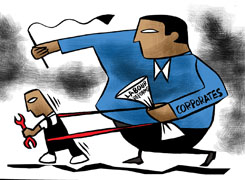Should I invest in mutual funds to build my retirement corpus and buy a home and car within 5 years?
Milind Vadjikar |1219 Answers |Ask -Follow
Insurance, Stocks, MF, PF Expert - Answered on Sep 10, 2024
He has a mechanical engineering degree from Government Engineering College, Sambhajinagar, and an MBA in international business from the Symbiosis Institute of Business Management, Pune.
With over 16 years of experience in stock investments, and over six year experience in investment guidance and support, he believes that balanced asset allocation and goal-focused disciplined investing is the key to achieving investor goals.... more

Hi I am 30 years , just started investing in mutual funds and my goal is to build good corpus for my retirement,buy a house and car in next 5 years . I have total 40 lakh in saving account which I have kept as i wana buy house soon so cant do fixed desosit. I am getting 20-25k interest per month on the same. my investment are as follows 1. Nifty 50 index fund - 10k per month sip 2. small cap - quant and nippon india 6k+6k total 12k sip 3. flexi- parag parikh - 10k Please review and suggest me best financial plan I have started investing recently and have consulted few financial planner to invest and have taken help of youtubers
The current SIP investments(funds are good) of 32K per month will yield you a corpus of 27+Lacs in 5 years(13% conservative return considered) which would help you part fund payment for house/car alongwith existing corpus(40L). Surely you may look at some home loan too.
For retirement I recommend you start investing in NPS systematically every month.
It is the most tax efficient(E-E-E) way of retirement planning and can provide market linked returns, based on your risk appetite and age.
You may follow us on X at @mars_invest for updates
Happy Investing
You may like to see similar questions and answers below
Ramalingam Kalirajan |8365 Answers |Ask -Follow
Mutual Funds, Financial Planning Expert - Answered on Jun 04, 2024
Ramalingam Kalirajan |8365 Answers |Ask -Follow
Mutual Funds, Financial Planning Expert - Answered on May 29, 2024
Ramalingam Kalirajan |8365 Answers |Ask -Follow
Mutual Funds, Financial Planning Expert - Answered on Jul 19, 2024
Ramalingam Kalirajan |8365 Answers |Ask -Follow
Mutual Funds, Financial Planning Expert - Answered on Aug 22, 2024
Archana Deshpande |107 Answers |Ask -Follow
Image Coach, Soft Skills Trainer - Answered on May 14, 2025
Archana Deshpande |107 Answers |Ask -Follow
Image Coach, Soft Skills Trainer - Answered on May 14, 2025
Mayank Chandel |2276 Answers |Ask -Follow
IIT-JEE, NEET-UG, SAT, CLAT, CA, CS Exam Expert - Answered on May 14, 2025
Mayank Chandel |2276 Answers |Ask -Follow
IIT-JEE, NEET-UG, SAT, CLAT, CA, CS Exam Expert - Answered on May 14, 2025
Mayank Chandel |2276 Answers |Ask -Follow
IIT-JEE, NEET-UG, SAT, CLAT, CA, CS Exam Expert - Answered on May 14, 2025
Mayank Chandel |2276 Answers |Ask -Follow
IIT-JEE, NEET-UG, SAT, CLAT, CA, CS Exam Expert - Answered on May 14, 2025
Mayank Chandel |2276 Answers |Ask -Follow
IIT-JEE, NEET-UG, SAT, CLAT, CA, CS Exam Expert - Answered on May 14, 2025
Radheshyam Zanwar |1626 Answers |Ask -Follow
MHT-CET, IIT-JEE, NEET-UG Expert - Answered on May 14, 2025
Radheshyam Zanwar |1626 Answers |Ask -Follow
MHT-CET, IIT-JEE, NEET-UG Expert - Answered on May 14, 2025
Mayank Chandel |2276 Answers |Ask -Follow
IIT-JEE, NEET-UG, SAT, CLAT, CA, CS Exam Expert - Answered on May 14, 2025






















